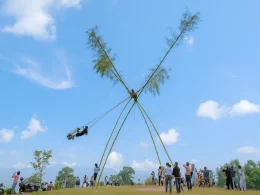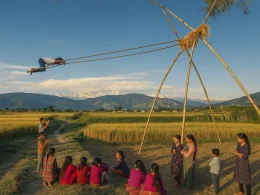Every year, as Dashain arrives in Nepal, the skies fill with colorful kites. Children run to rooftops, families gather together, and laughter echoes across neighborhoods. The Dashain kite flying tradition in Nepal is more than just fun—it carries history, spirituality, and deep cultural meaning.
Let’s explore how kites reached Nepal, why we fly them during Dashain, and what makes this tradition so special.
The Ancient Origins of Kites

Kites have a history that stretches back nearly 3,000 years to China. Early kites were crafted with bamboo and wood frames, covered in silk or paper, often designed to resemble birds.
Chinese philosopher Mozi (5th century BCE) is often credited with developing the first kites. By 549 AD, paper kites had practical uses:
- Signaling messages across distances
- Measuring wind direction and speed
- Lifting men into the air
- Helping military generals in strategic planning
One of the earliest records tells how General Han Hsin (around 200 BCE) used a kite to measure the distance needed for tunneling under a city wall. From the very beginning, kites were tools of creativity, science, and communication.
How Kites Came to Nepal
The kite flying tradition in Nepal likely arrived through Newar traders who had active trade routes with Tibet and China. Historical records say that kite flying once happened all year round in the Kathmandu Valley.
But the sharp strings began injuring local birds. To solve this, legend says the king and the birds signed the “Treaty of Kathmandu.” This mythical agreement restricted kite flying to just one season—Dashain.
And so, kites became inseparable from Nepal’s biggest festival.
Why We Fly Kites During Dashain

Dashain comes right after the monsoon ends, when farmers prepare to harvest their crops. The timing makes kite flying both symbolic and practical. Here’s why it matters:
1. Spiritual Connections
- Honoring ancestors: Families believe kites carry messages to ancestors, assuring them their descendants are well.
- Guiding souls to heaven: People fly kites to help recently departed souls—both human and animal—find their way to the heavens.
- Prayers to Indra, the rain god: Flying kites sends a message to Indra, asking him to stop the rains so the harvest can happen safely.
2. Cultural and Social Joy
- Togetherness: Dashain kite flying brings families to rooftops and open fields, creating moments of bonding.
- Prosperity and good fortune: Kites are seen as symbols of luck, inviting positive energy into homes.
- The Treaty of Kathmandu myth: The legend reminds us of Nepal’s balance between nature and human celebration.
3. Expression of Skill and Fun
- Colorful skies: During Dashain, the bright kites create a festival of colors above Kathmandu.
- Kite fighting: The playful challenge of cutting another person’s kite string adds thrill, showing off dexterity and strategy.
The Modern Dashain Kite Flying Tradition in Nepal

Today, the kite flying tradition is alive and vibrant. As Dashain approaches:
- Markets buzz with handmade kites in every size, shape, and color.
- Families gather on rooftops to compete, cheer, and celebrate together.
- Kids proudly chase the fallen kites they’ve cut loose.
- In urban areas, kite flying has grown into a spectator sport, with friendly competitions and community events.
Even with modern pastimes, kites hold their charm. They carry nostalgia for older generations and joy for the younger ones.
Why This Tradition Still Matters

The Dashain kite flying tradition in Nepal has survived for centuries because it represents so much more than a hobby. It blends:
- History from ancient Chinese roots
- Spiritual meaning that connects families to ancestors and gods
- Cultural togetherness that keeps communities united
- Joyful expression that lights up the skies every autumn
When families release kites into the Dashain sky, they’re not just playing—they’re carrying forward a legacy of belief, unity, and celebration.
Conclusion
The Dashain kite flying tradition in Nepal is a colorful reminder of how culture, spirituality, and joy can blend into a single festival activity. Rooted in ancient history, enriched by myths like the Treaty of Kathmandu, and kept alive through family traditions, kite flying continues to connect Nepalese families with their ancestors, their communities, and the skies above.
So, the next time Dashain arrives and kites dance across the blue skies of Nepal, remember: each kite tells a story of heritage, hope, and happiness.
See Nepal in every scroll: Follow us on Facebook, Instagram, and TikTok for stories that bring the country to life.









